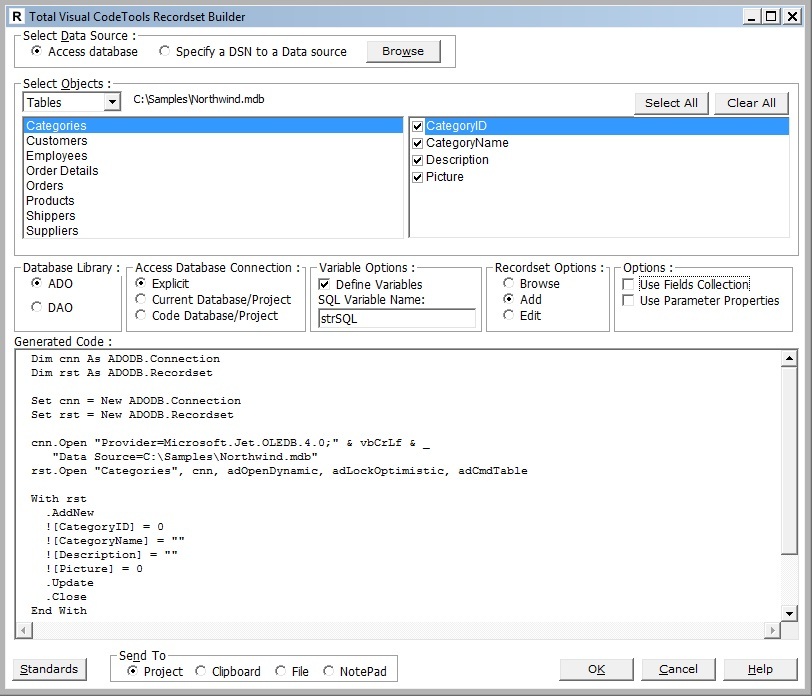

- #Vba recordset loop through records wizard software#
- #Vba recordset loop through records wizard code#
- #Vba recordset loop through records wizard free#
- #Vba recordset loop through records wizard windows#
One possible solution is to copy the worksheet in the OLE field into a new Excel workbook, then save that workbook. For Excel, the OLE object that you can add to the OLE field is only an Excel worksheet, saving just the worksheet is not a complete Excel file and so the Excel application will not open it.
#Vba recordset loop through records wizard code#
Another way to phrase this problem is that you have to customise the code according to the object model of the OLE object. One shortcoming of the method above is that not all OLE object support the “.SaveAs” method. Manipulating OLE objects can be slow, in some systems you need to add some DoEvents to keep out errors. The program should export all the OLE objects from the position on to the end of the records. You can start at whatever position within the records inside the form and click this button.

With reference to, we can create another button CmdLoop with the following code: Private Sub CmdLoop_Click() While Me.CurrentRecord <= Me.Recordset.RecordCount DoEvents CmdExport_Click DoEvents DoCmd.GoToRecord Record:=acNext Wend End Sub The next part is to loop through the records in the form. The name of the file includes the primary key, as we are going to export many records and I have to make sure the file name is unique. When you press this button, a Word document file will be saved to the “Document” folder. With reference to, we can create a button CmdExport in the form with the following code: Private Sub CmdExport_Click() Set OLEobj = Me.OLEField OLEobj.SaveAs "Test" & Me.ID.Value & ".docx" Set OLEobj = Nothing End Sub So if you just have a few records, you can do it manually, but if you have hundreds of record, you may need to automate this export process. This OLE embedding in Access form demonstrated the power GUI that I had never thought of before.īack to the task, to create a simple illustration, I create a table with a primary key and an OLE object field in Access:
#Vba recordset loop through records wizard windows#
Windows 95 was the first Microsoft operating system that booted into a GUI by default.

When I discovered this feature back in Access 97 where GUI was still a new thing, I was impressed. As we will see, in an Access form, you can embed and edit that file within the form. OLE stands for Object Linking and Embedding( 1, 2) and you can just treat all types of different documents - Word, Excel, PowerPoint as one single data type - OLE. In the olden days of Windows, there was no binary objects or attachments in Access, OLE objects was the way to go.
#Vba recordset loop through records wizard free#
I was aware of a free solution but was too busy to write it up until now.
#Vba recordset loop through records wizard software#
Working Code: Private Sub btnTransfer_Click()ĭoCmd.I found on the Internet a number of discussions on exporting embedded OLE fields out of Microsoft Access but either there was no solution or you have to buy some software to complete the task. Very simple fix but it did take me a while unfortunately, hence the reason for posting as I needed an extra pair of eyes! Instead I used the "AutoID" variable value as the first field on the destination table when looping through the code. The main reason I was getting incorrect values in the destination table was because using the "accountNumber" variable was not necessary. Set bStocked = dbs.OpenRecordset("SELECT * FROM tbl_BrandsStocked")ĭoCmd.RunSQL "DELETE * FROM WHERE Is null" Set temp = dbs.OpenRecordset("SELECT * FROM tbl_TempProducts WHERE id IS NOT NULL") Please see code below: Private Sub btnTransfer_Click() Please forgive me if this is not clear enough as this is my first post! The code works but the order in which it 'pastes' the code into the destination table is incorrect. I want to create a new record in tbl_BrandsStocked for every 7th field in tbl_TempProducts. The first value of the record in tbl_TempProducts should be used as the first value in every new record in tbl_BrandsStocked as long as the values being transferred are in the same record as the record we are transferring from. Whilst doing this the row with the fields I want to 'copy and paste' from needs to be split into various rows of another table. I am writing some code for an access database (Access 2010) and need to extract non-empty fields from a table into another (tbl_TempProducts to tbl_BrandsStocked).


 0 kommentar(er)
0 kommentar(er)
